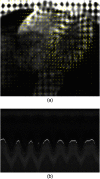Quantitative simultaneous positron emission tomography and magnetic resonance imaging
- PMID: 26158055
- PMCID: PMC4306197
- DOI: 10.1117/1.JMI.1.3.033502
Quantitative simultaneous positron emission tomography and magnetic resonance imaging
Abstract
Simultaneous positron emission tomography and magnetic resonance imaging (PET-MR) is an innovative and promising imaging modality that is generating substantial interest in the medical imaging community, while offering many challenges and opportunities. In this study, we investigated whether MR surface coils need to be accounted for in PET attenuation correction. Furthermore, we integrated motion correction, attenuation correction, and point spread function modeling into a single PET reconstruction framework. We applied our reconstruction framework to in vivo animal and patient PET-MR studies. We have demonstrated that our approach greatly improved PET image quality.
Keywords: motion correction; point spread function modeling; positron emission tomography and magnetic resonance imaging; positron emission tomography attenuation correction; surface coils.
Figures






References
Grants and funding
LinkOut - more resources
Full Text Sources
Other Literature Sources

